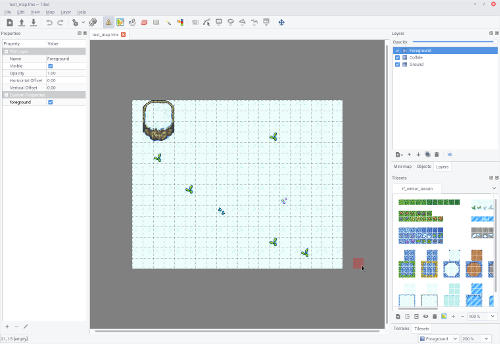Third party tools: Tiled
In order to save time in programming my game engine, I’m relying heavily on third party libraries and tools. Probably my biggest dependency is the Tiled map editor. Tiled is an open source project and is an extremely powerful tool for creating tile-based maps. It also has an open file standard that many people have written libraries for.
The screenshot above shows my test map loaded into the editor. It has a lot of ready-made features like layers and painting tools. It also allows you to specify custom properties on layers and map objects, which I use for a variety of engine-specific data points. I remember programming a similar tool in Java many years ago and it took quite a bit of work just to get to the point where I could paint tiles in a grid, so having an off-the-shelf solution like this was perfect.
Additionally, since there were so many frameworks to choose from that could parse Tiled’s .tmx format, it was pretty easy to get my prototype working with Tiled maps quickly. All I had to write was the rendering code. Initially, I used TMX C Loader since it was pretty lightweight and already had an SDL-based example for doing the rendering part. My first draft of my tilemap renderer was essentially a modified example from this repository. (As an aside, I tend to default to using C libraries rather than C++ despite the engine being written in C++… I’ll probably do a separate post about that sometime later.) This worked really great at first… until I tried to get it working on Windows.
I didn’t start doing Windows builds until about a month into the project, so I already had quite a bit of code in place, which was probably my first mistake, but I didn’t want to distract myself with porting things until I had a small prototype working. Anyways, getting TMX C Loader to work on Windows wasn’t as straightforward as I hoped. While the library itself had no issues in portability, it brought in a dependency on libxml2. Supposedly libxml2 is also portable, but I had a hell of a time getting it to compile in all the configurations I needed under Visual Studio 2015. So it was back to the drawing board.
Eventually I settled on tmxparser, which is an actual C++ implementation that depends on TinyXML. I had a much easier time getting this combination to compile on every platform and configuration that I want to support (currently Linux and Windows for both 32-bit and 64-bit). The structure of tmxparser’s API was quite different to TMX C Loader, so I did end up rewriting a substantial part of my tilemap implementation, but in the end it all worked out. The only issue I ran into is that tmxparser never implemented support for layer offsets, so I had to patch that in myself, but that’s the great thing about open source: I was able to patch the library in a few minutes and keep going.
For the same reasons as above, I also ended up swapping another library I was using, which was LibYAML. I’ve always appreciated YAML’s brevity and expressiveness for configuration files, so a lot of my game configuration data was stored in YAML files. After having some porting issues with LibYAML, I did some more research on different markup languages that could support my engine. Through this, I discovered TOML, which seemed to solve a lot of the same problems that YAML did. So I tried out cpptoml as a dependency and rewrote my configuration files, and now everything works amazingly well.
Using these third party tools, I was able to get my prototype to a viable state much faster than if I had stopped to do the tooling myself. This is the hybrid approach that I talked about in my previous post about choosing C++ and SDL2 over an off-the-shelf engine; it’s just flexible enough that I can make it do what I want, but I still save hundreds or even thousands of hours of work. Sometimes it means making a few compromises and accepting the limitations of what I can find that’s already built, but so far I’ve been very happy with the solutions I’ve discovered.
